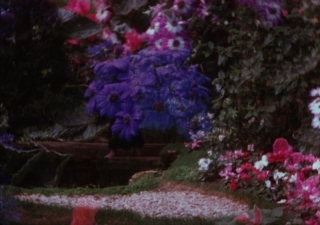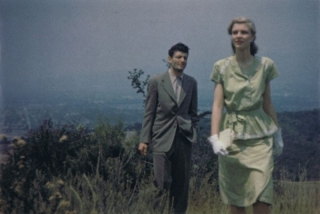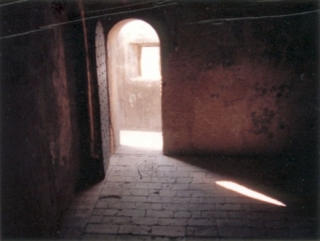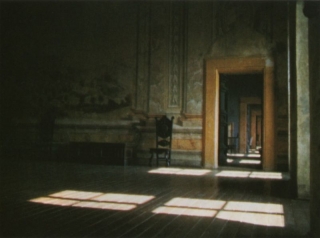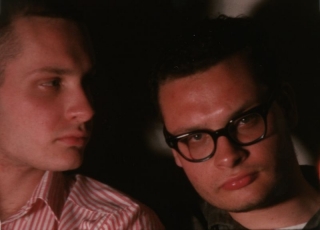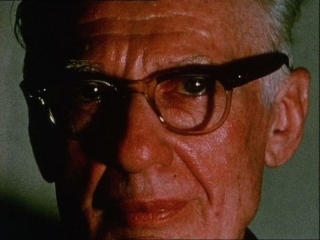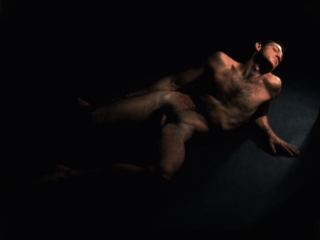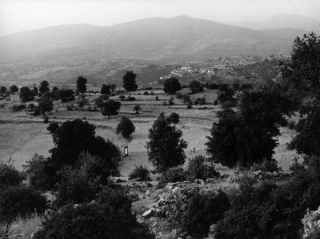Date: 12 October 2014 | Season: Gregory Markopoulos: Film as Film | Tags: Gregory Markopoulos
MARKOPOULOS 2
Sunday 12 October 2014, at 7pm
Brussels L’age d’or Festival at Cinematek
Introduced by Mark Webber and Robert Beavers
Gregory J. Markopoulos, Bliss, 1967, 6 min
Gregory J. Markopoulos, The Illiac Passion, 1964-67, 92 min
A visionary interpretation of the myth of Prometheus, The Illiac Passion is also one of the most acclaimed movies of the author. In this ode to creation, Markopoulos gave Jack Smith the role of Orpheus, casts Andy Warhol as Poseidon and Gregory Battcock as Phaeton. Bartók’s musical passages and text excerpts from Aeschylus, translated by Thoreau and read by Markopoulos, compose the soundtrack. Preceded by a lyrical description of a Byzantine church on the Greek island of Hydra.
Date: 13 October 2014 | Season: Gregory Markopoulos: Film as Film | Tags: Gregory Markopoulos
MARKOPOULOS 3
Monday 13 October 2014, at 4pm
Brussels L’age d’or Festival at Cinematek
Introduced by Mark Webber and Robert Beavers
Gregory J. Markopoulos, Du sang, de la volupté et de la mort, 1947-48, 70 min
Addressing head-on the issue of homosexuality, these three sensual films – the first made by Markopoulos on 16mm, were condemned by the American press, who did not hesitate to call them degenerate. Psyche (1947, 23 min), is inspired by an unfinished novella by Pierre Louy?s, while Lysis (1948, 30 min) and Charmides (1948, 15 min) are based on dialogues by Plato. Shots of contemporary life are combined with fascinating arrangements of objects, books, paintings and textiles, freely punctuating this narrative with mythological references.
Screening repeats Tuesday 14 October at 8pm
Date: 13 October 2014 | Season: Gregory Markopoulos: Film as Film | Tags: Gregory Markopoulos
L’ÂGE D’OR: MARKOPOULOS 3
Monday 13 October 2014, at 8pm
Brussels L’age d’or Festival at Cinematek
Introduced by Mark Webber and Robert Beavers
Gregory J. Markopoulos, Gammelion, 1967, 50 min
Gregory J. Markopoulos, The Olympian, 1969, 23 min
In Gammelion, one of the most important works of Markopoulos’s filmography, seven minutes of footage shot in the castle of Rocca Sinibalda (Italy) follow a complex score using hundreds of fade outs and are extended to almost an hour. Images and sounds emerge from the darkness and silence resulting in a composition of stunning beauty. “To be loved means to be consumed. To love means to radiate with inexhaustible light. To be loved is to pass away, to love is to endure.” (Rilke). Followed by a portrait of Alberto Moravia filmed in Rome two years later.
Screening repeats Tuesday 14 October at 6pm
Date: 31 October 2014 | Season: Gregory Markopoulos: Film as Film | Tags: Gregory Markopoulos
GREGORY J. MARKOPOULOS: FILM AS FILM
Friday 31 October 2014, at 6:30pm
London Tate Modern
Gregory J. Markopoulos is a key figure in the history of independent film and was, alongside Kenneth Anger, Stan Brakhage, Maya Deren and Andy Warhol, a pioneer of the New American Cinema of the 1960s. This special evening celebrates the publication of Film as Film: The Collected Writings of Gregory J. Markopoulos, edited by Mark Webber, that gathers together for the first time the writings of this important filmmaker.
Gregory J. Markopoulos, Psyche, USA, 1947, 16mm, 25 min
Gregory J. Markopoulos, Bliss, Greece, 1967, 16mm, 6 min
Gregory J. Markopoulos, Gammelion, Italy, 1968, 16mm, 55 min
The evolution of Markopoulos’ filmmaking – from the early films of the 1940s to his increasingly poetic and metaphysical works made in Europe from the late 1960s onwards – is traced in his writings, which also address the avant-garde cinema, auteurs such as Dreyer, Bresson and Mizoguchi, and the work of his partner Robert Beavers. As Markopoulos pursued his ambitious plan to establish The Temenos, a screening space and archive devoted to his work that would be located in a remote part of Greece, his unique vision of a truly independent cinema was proposed through his texts and has inspired a diverse array of artists. Tacita Dean has celebrated the forthcoming publication stating, “it feels apposite that the writings of Gregory Markopoulos be published now at a time when the very existence of film is so threatened. Nothing more should be needed as a convincing argument that film is still the important, autogenic magical medium for filmmakers today.”
Following screenings of films by Gregory J. Markopoulos at Tate Modern in 2008, this evening will feature works not previously shown at Tate that illustrate key points in Markopoulos’ career interspersed with readings from the book. Made while studying at USC in Los Angeles, Psyche 1947, was his first 16mm film, and demonstrates Markopoulos’ developing style and his sensuous use of colour and composition. Shot in the Hollywood hills, the film was inspired by an unfinished novella by Pierre Louÿs, yet as Markopoulos described “the first thing which I did was to delete the novelette of its lush rhetoric and retain only its symbolic colour. In Psyche, colour plays an important role, similar to the role which colour plays in the paintings of Toulouse Lautrec. Colour reflects the true character of the individual before us, whether it be on the screen, in a painting, or in the street. Colour is Eros.” (Psyche’s Search for the Herb of Invulnerability, 1955).
Bliss 1967, the first film made after Markopoulos moved from the USA to Europe, is a lyrical study of the interior of the Byzantine Church of St. John on the island of Hydra. Using only available light and edited in camera, Bliss demonstrates the filmmaker’s aesthetic economy and rigour. Gammelion 1968, filmed at Il Castello Roccasinibalda in Rieti, Italy, is a major work in Markopoulos’s oeuvre, marking the transition into his late period and anticipating his epic final film, Eniaios 1947-91. Shot with only two rolls of film, the work extends seven minutes of footage to almost one hour of viewing time using hundreds of fades in and out. As lines of poetry, music, or the sound of horses’ hooves are heard on the soundtrack, images appear for only a few frames at a time, creating a remarkable romantic vision of a poetic cinema conjured from its essential components.
Curated by George Clark and Mark Webber. Introduced by Mark Webber and Robert Beavers.
Date: 19 November 2014 | Season: Gregory Markopoulos: Film as Film | Tags: Gregory Markopoulos
DU SANG, DE LA VOLUPTÉ ET DE LA MORT
Wednesday 19 November 2014, at 6:30pm
Vienna Austrian Filmmuseum
Introduced by Robert Beavers and Mark Webber
Gregory J. Markopoulos, Du sang, de la volupté et de la mort, 1947–48, 59 min
1947 arbeitet er, Sohn griechischer Emigranten, an der Erschaffung von Filmen, angetan, sich in Sachen Schönheit und Perfektion mit den schönsten, perfektesten amerikanischen movies messen zu können, anderseits bestimmt dazu, keinem je zuvor (und danach) entstandenen Hollywood- oder narrativen Film bezüglich Komplexität und Vision auch nur annähernd zu gleichen. Jahre vor dem Nouveau Roman entfachen Psyche, Lysis und Charmides Zeit-Labyrinthe. Augenblick, zu Film entfaltet, welcher weder Beginn oder Ende noch einen dem Zeiger der Uhr gehorchenden Ablauf kennt. Nichts, was Boden unter den Füßen gewährt. Zeitfunken-Regen, sinn-betörend. Springende, repetierende, vor- und rückwärts lesbare Narration: Rätsel-Geschichten über Sehnsucht und Qual. All jene, die in diesen, den „Spielfilm” ins Stadium erweiterter Verrückung (genannt ekstasis) treibenden Arbeiten die Funktionen Produktion, Regie, Buch, Kamera, Schnitt, Montage, Beleuchtung, Auswahl der Akteure, Musik und Dekors ausfüllen, tragen einen einhelligen Namen: Gregory J. Markopoulos. (Harry Thomicek)
Date: 19 November 2014 | Season: Gregory Markopoulos: Film as Film | Tags: Gregory Markopoulos
MING GREEN / GALAXIE
Wednesday 19 November 2014, at 8:30pm
Vienna Austrian Filmmuseum
In the presence of Robert Beavers
Gregory J. Markopoulos, Ming Green, 1966, 7 min
Gregory J. Markopoulos, Galaxie, 1966, 82 min
Ming Green: portrait of a place. Der Ort: ein Apartment in N.Y., über Jahre hin von M. bewohnt, das er verlassen muss, das er filmt. Lament: poem for a room. Das Porträt:Bilder, in denen andere zucken, immer mehr, bis Ming Green zu einem einzigen polyrhythmisch-polymorphen Pulsieren und Blinken von erinnerungsgrünen Bildern in Bildern geworden ist. Galaxie: portraits of persons – und das vielleicht makelloseste Werk eines Filmemachers am Zenit. 30 Drei-Minuten-Porträts von Künstlern und Freunden. Zu Gesichtern geworden, verharren sie in Schweigen, in Ernst, in den Tiefen ihrer Existenz und Untiefen ihres Fleisches, das in den Doppel- und Vielfach-Belichtungen des Films zu fließen beginnt. 30 radikale Tonfilme über Stille. Und Filme über Finalität: am Ende läuten jeweils silberne Schläge Porträt und Porträtierten ab. 30 Zeit-Gemälde darüber, was sich an Personen zeigt und verbirgt. Film über Geheimnis. Oder dessen Mehrzahl. (Harry Tomicek)
Date: 20 November 2014 | Season: Gregory Markopoulos: Film as Film | Tags: Gregory Markopoulos
TWICE A MAN
Thursday 20 November 2014, at 6:30pm
Vienna Austrian Filmmuseum
In the presence of Robert Beavers
Gregory J. Markopoulos, Twice a Man, 1963, 47 min
Charles I. Levine, The Filming of Twice a Man, 1963, 3 min
Gregory J. Markopoulos, Through a Lens Brightly: Mark Turbyfill, 1966, 14 min
Superlativen eignet ein Zug zum juvenil Törichten. Dennoch ist es schwer, Twice a Man nicht als den extremsten, fremdartigsten „Spielfilm” in der Geschichte des Mediums zu feiern. Zwei Männer und eine Frau, gedoppelt in zweierlei Erscheinungen ihrer selbst, treffen in der Stadt N.Y. aufeinander. Ihr Sprechen bleibt stumm und die Passion in ihren Gesichtern und Gesten spricht oder schweigt in einem erregend fremden Maß wie der Anblick ekstatisch aufeinander bezogener Personen, die man von einem Zug aus im Fenster eines anderen Zuges erspäht. Personen in schimmernden Bildern, die stets Blicke und Gedankenbilder anderer Personen zu sein scheinen. Aber nie verrät Twice a Man, wer es ist, der sieht oder denkt, und ob dieses Sehen-Denken sein wird, war oder ist. Through a Lens Brightly zeigt den Tänzer-Poeten Mark Turbyfill in Glanz und Tanz, die beide nicht durch ihn vor der Kamera, sondern in dieser und durch sie hervorgebracht worden sind. (Harry Tomicek)
Date: 20 November 2014 | Season: Gregory Markopoulos: Film as Film | Tags: Gregory Markopoulos
THE ILLIAC PASSION
Thursday 20 November 2014, at 8:30pm
Vienna Austrian Filmmuseum
In the presence of Robert Beavers
Gregory J. Markopoulos, The Illiac Passion, 1964-67, 91 min
Gregory J. Markopoulos, Rushes for The Illiac Passion, c.1965, 12 min
Gregory J. Markopoulos, Test with Masques for The Illiac Passion, 1966, 3 min
„Illiac” beschreibt das Auf- oder Erstellen einer Sache. Es ist ein anderer Name für poiesis, das Ursprungswort fürs Erschaffen, für das Filme-in-die-Welt-Setzen des „Filmemachers”. The Illiac Passion ist ein Film-als-Film-Kontinent und poetisch verschlüsseltes Selbstporträt, mit dem Markopoulos über sich als einen anderen (namens Prometheus) und über die Leidenschaften des Erzeugens von Werken (also auch von Filmen, also auch über die passions von Illiac Passion) erzählt. The Illiac Passion ist ein Mythen-Irrgarten, beglänzt vom Licht des Sterns Farbe-ist-Eros. Film, in dem Griechenlands Götter sich nach Manhattan begeben und in dem das Erhabene und Gewöhnliche nicht müde werden, einen tollkühnen, tragischen, magischen Tanz aus flackernden single frames, Doppelbelichtungen, Metaphern und schierer Bildpracht zu tanzen: die Summe der maßlosen wie maßvollen Markopoulos-Filmschrift. (Harry Tomicek)
Date: 21 November 2014 | Season: Gregory Markopoulos: Film as Film | Tags: Gregory Markopoulos
BLISS / GAMMELION
Friday 21 November 2014, at 6:30pm
Vienna Austrian Filmmuseum
In the presence of Robert Beavers
Gregory J. Markopoulos, Bliss, 1967, 6 min
Gregory J. Markopoulos, Gammelion, 1967, 54 min
Das Bild einer Ölleuchte in der Agios-Ioannis-Kirche, Hydra. Das Bild der Feste Roccasinibalda, Rieti. Das Bild des Gesichts von Alberto Moravia (The Olympian – im folgenden Programm). Markopoulos verknappt Bilder: single shots werden single frames. Die Kürze steigert die Intensität des Bildes: es wird zum Blitz, zum Aufleuchten. Es bricht aus der Nacht der Schwarzkader hervor und verlischt wieder darin. Es gerät zu einem das Auge attackierenden Ereignis der Zeit. Die Präsenz des Bildes als eines im Minimum maximalen Ereignisses ist so bedeutsam für M., dass er es nicht einmal, sondern wiederholt zum Aufscheinen bringt. Wie Feuer kündigt es sich durch Funken an und zieht solche hinter sich her – so, als würde das Bild in stiebendem Tanz sich in seine Vorahnungen und Erinnerungen zerteilen, um darin zu bleiben (oder zu werden), was es ist. So wird das aufgesplitterte Bild zugleich zu seinem Rhythmus – und zum Puls des Films. (Harry Tomicek)
Date: 21 November 2014 | Season: Gregory Markopoulos: Film as Film | Tags: Gregory Markopoulos
STARRY NIGHT: MARLOPOULOS AND THE TEMENOS
Friday 21 November 2014, at 8:30pm
Vienna Austrian Filmmuseum
Introduced by Robert Beavers and Ian Wooldridge
Gregory J. Markopoulos, Four reels from ENIAIOS IV, 1947-91
In den 1970er Jahren zieht Markopoulos, angeekelt von der Kommerzialisierung und enttäuscht vom Vertrieb des Independent Cinema, sein Werk von der Öffentlichkeit zurück, um an dessen kompletter Zusammenfassung und Neugestaltung zu arbeiten. Ein gigantisches Unterfangen, das der Tod unterbricht und dessen Zugänglichmachung seit 1992 von Robert Beavers betrieben wird. 80-stündiges Œuvre, gegliedert in 22 mehrstündige Zyklen. Balanciertes Sich-Antworten, Einander-Durchdringen, Aus-und Einschließen von narrative films, portraits und places,insgesamt fordernd, als jene Einheit und Einzigartigkeit gesehen zu werden, die das Wort eniaios im Titel verkündet. Als Einübung in kompromisslosen Ernst und als Heilungsabenteuer durch die höchste aller Künste. Supreme art. Film as Film. Not for everybody. But for every one. (Harry Tomicek)
Robert Beavers spricht über sein und Gregory Markopoulos’ Temenos-Projekt und präsentiert – ausnahmsweise im Kino – vier Akte aus den ENIAIOS-Zyklen. Der Künstler Ian Wooldridge erzählt von der praktischen Restaurierungsarbeit an ENIAIOS.
